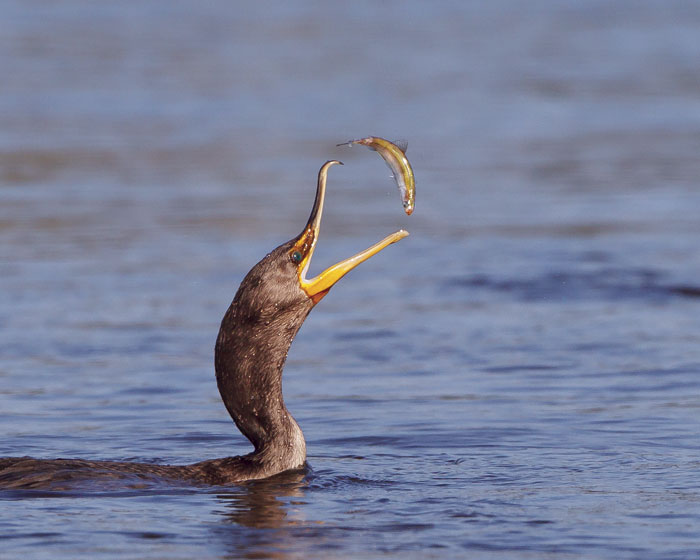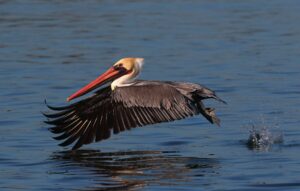“Don’t look down,” instructed our Caltrans escort. That’s cold comfort when you’re stepping over the railing of the Bay Bridge. I try to ignore the bouncing of the bridge, a cold thrumming vibration with the background roar of traffic. Staring over the rail at the opaque, jade-colored Bay 160 feet below, I take a step on the iron catwalk to descend to the undercarriage of this giant erector set. I’m about a mile east of Treasure Island and actually quite relieved to be off the road and under the eastbound lane of the bridge. Ten feet above some 10,000 vehicles pass by every hour.
I see mounds of cigarette filters that have blown into the scaffolding’s steel corners, an accumulation of butts flicked out of car windows for 50 years. And I notice a potential gold mine of bird guano that Caltrans could sell as boutique fertilizer. Wearing a full body harness with two six-foot lanyards attached to clasps, I position myself on “the traveler,” a motorized platform suspended from rails under the bridge used by maintenance crews. Lying on my back, I slowly inch along—cargo netting slung beneath me in case I accidentally roll off the traveler—and stare up at the bridge’s underworld. As I inch closer to the roosting birds, they watch me with a mix of curiosity and alarm. Heads nod and necks crane, suggesting they are growing more concerned as I approach.
Since I first began looking beneath bridges in 1988, I have leaned over, stepped off, or crawled below the old Bay or Richmond-San Rafael bridges a dozen times in search of the double-crested cormorants that have nested, for at least 30 years, amid the structure’s iron lattices. I’ve surveyed the birds’ changing population in the Bay Area and monitored their tolerance of people during bridge maintenance. Over the past three decades, the Bay Area cormorant population has fluctuated from around 1,200 to 2,200 pairs—that’s about 30 percent of California’s double-crested cormorant population and 10 percent of the Pacific coast population. In 1999, my colleagues and I counted at least 794 nests beneath the old Bay Bridge.
It’s a remarkable world to witness. Under the bridge, the messy stick nests line the horizontal beams, at times by the hundreds, often built just out of striking distance from a neighbor’s beak. The sides of the oldest nests can be stacked two feet high. Other nests are tucked into the angles and intersections of iron beams. Brooded by the parents until they grow strong, the chicks climb from the nests and fill the girders, nodding heads begging for attention and food. It is an apartment complex like no other.
But in April, as the last of the old Bay Bridge comes down, this classic and lengthy case of wildlife claiming our urban world as its own will be over.

You may be familiar with cormorants’ habit of perching with their wings outstretched. There’s a biological explanation for that behavior, just as there is for double-crested cormorants (Phalacrocorax auritus) choosing to make their homes under our bridges. Cormorants are submarine feeders, catching their meals underwater. After a feeding session they’re often soaked because their feathers lack the waterproofing most birds have to repel moisture. Less buoyant feathers make underwater foraging more efficient, but it also means cormorants must dry off with their wings “spread-eagle.“
The cormorants’ throat pouch and totipalmate feet—the webbing stretched between the four toes—place it in the pelican order, Pelecaniformes. Those flipper feet power their underwater foraging as they hunt in the Bay. But unlike other cormorants in the San Francisco Bay, double-crested cormorants can use their totipalmate feet to grasp branches and railings, enabling them to nest in trees and on bridges where they build their colonies of bulky nests, not only from sticks, but also from leaves, seaweed, and marine debris like rope, caution tape, plastic containers, and even condoms!
Those nests become especially important in the spring, when the double-crested cormorant’s pair of filamentous, nuptial crests—some white, some black or salt-and-pepper—emerge on both males and females and last just about two weeks in April or May. Their namesake feature appears only during the height of the courtship phase when hormones are running high and before they get down to raising chicks, molting into their plain plumage.
Back in the late 1800s before bridges spanned the Bay, several thousand double-crested cormorants nested on Lands End near Seal Rocks off the coast of San Francisco and on the Farallon Islands. The great ornithologist of the era, Robert Ridgway, described the Pacific Coast bird as a subspecies of the double-crested cormorant found throughout North America and he gave them their own moniker—the Farallon cormorant (P. a. albociliatus). The Latin refers to its white crests, unique to the West Coast birds, and its common name to the locality in central California where the first specimen was scientifically described. But through years of nest disturbance and coastal development, the mainland population dwindled to fewer than 50 pairs by the early 1900s. Another few hundred pairs survived on the remote Farallon Islands.
Double-crested cormorants struggled to survive in the region and nationwide due to habitat loss, fishermen who viewed the birds as competition and thus persecuted them, and the effects of pesticides on nesting success. But new habitat awaited with the completion of iron truss bridge works over the Bay in 1936 and 1956. It took time before the cormorants exploited that. They were first documented nesting on the Bay and Richmond-San Rafael bridges in 1984, though bridge workers reportedly saw them 20 years earlier on the latter.
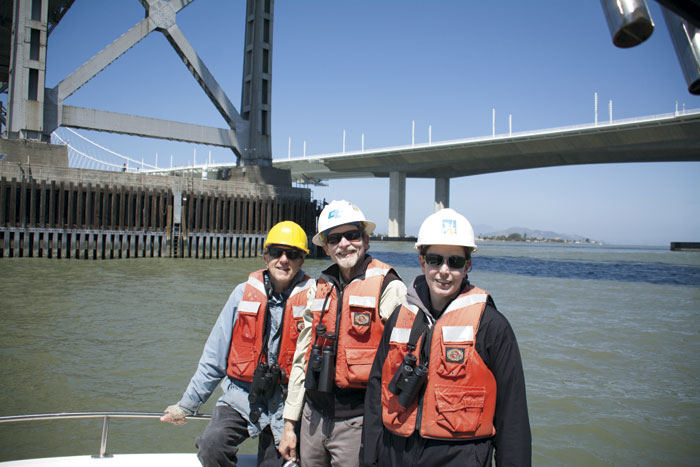
I began studying those double-crested cormorants under the Richmond-San Rafael Bridge with Point Reyes Bird Observatory (PRBO, now Point Blue Conservation Science) in 1988. I was a seabird biologist trained in Alaska and Hawai’i, had recently moved to Oakland, and found cormorants were the neglected seabird that appeared to have few admirers. At that point, double-crested cormorants were undergoing a population expansion both locally and nationally from their near extirpation in the last century. When Chevron contracted PRBO to conduct a three-year study of cormorant nesting success, because the company was cognizant that an outfall pipe being relocated to deeper Bay waters might impact the corms’ feeding grounds, we had a chance to study them in the Bay for the first time.
To survey the population on the Richmond Bridge, my colleagues and I needed two methods. To gather breeding success data, we coordinated a closure of the passing traffic lane early on Saturday mornings during breeding season (March to August) from 1988 to 1990. From the bridge deck we could look over the rail and eight feet below the roadway to see birds nesting in a row on the I-beams. We used a long “prodder” to move the adult birds and count the eggs and observe how the chicks developed. The pale blue chalky eggs hatched into fat squabs, looking like big black ticks, and eventually feathering out into the gawky, downy stage (think 11-year-old tweeners), always flagging their orange throats at the parents, begging for food. But the “beamers” were not the whole colony. We also needed a boat to count the birds nesting underneath the bridge in the ironworks. We surveyed from the boat early Friday mornings and conducted the road survey at the same hour on Saturday mornings. As the captain positioned the boat, we would agree what section to count, and then, like reading a sheet of music with binoculars, our eyes played up one beam and down the next, noting the black birds clumped together at a nest or positioned alone. Trying to stay focused while on the rocking boat was the big challenge; losing count meant a redo and a step closer to seasickness.
After the Chevron contracts to study cormorants—from ’88 to ’90, followed by a one-year intensive study in 2000—were completed, we volunteered to continue conducting population counts and collect other data on the birds. It had become clear that cormorants are a sentinel species for the open waters of the Bay. As full-time residents, catching fish from a variety of contaminated shallow-water habitats, they can reflect the ecosystem’s health. For example, serious birth defects, like crossed bills, had shown up in the Great Lakes cormorants due to pollution, and we wanted to know if that was happening in the Bay. Our results were encouraging. Not only was the population increasing, the Bay cormorants appeared free of genetic defects. Their tissue samples showed decreasing levels of pesticide residues, although the results were mixed for PCBs, mercury, and selenium—all of which can impact embryo development—at the Richmond Bridge colony. Our findings reflected the declining use of organochloride pesticides in farming since the 1970s, which has helped eliminate eggshell thinning and the consequential effects on reproduction.
Our research was also motivated by the changing marine ecosystem. Overfishing meant different species of fish were available to cormorants; as “fishing down the food web” resulted in fewer larger fish, smaller prey populations grew. As an opportunist, the double-crested cormorant benefited, feeding on a wide diversity of fish, from plainfin midshipman in Sausalito to stocked trout in Lafayette. Add to that the increase in invasive marine species, development, pollution, and a reduction in freshwater flows, and it’s clear cormorants are among the rare examples of indigenous marine species that have successfully adapted to the drastic ecological shifts in the Bay, where a significant portion of marine species (more than 50 percent of the fish and most of the bottom creatures) are introduced from other parts of the world.
The Bay bridges have provided the cormorants with both benefits and challenges: They got a short commute to feeding grounds and a cool place to nest, but they have also had to contend with required bridge maintenance. It’s an “only in San Francisco” story.
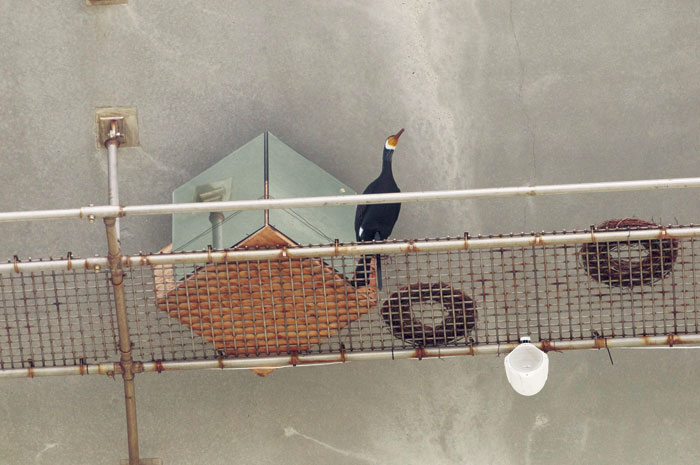
All this changed on October 17, 1989, when the Loma Prieta earthquake cracked the Bay Bridge right above the colony (not the birds’ fault!). Although it took years of political wrangling to settle on a new bridge design that was acceptable to all parties, the resulting plan included an agreement to provide habitat replacement for the cormorants on the new bridge.
In the fall of 2001, I met with the bridge designers to discuss what a couple thousand cormorants might need for nesting habitat. As I provided the birds’ measurements, the designers provided the space. Given the landmark status that drove the bridge project forward, as well as the gleaming white cement signature style, the cormorant colony had to be situated in the center of the bridge, out of sight. Six thousand square feet of stainless steel “corm condos” were built in long rows facing each other under the roadway, designed to be an accessible and manageable replacement given the design limitations and as a mitigation for the colony on the old bridge. Phil Matier of the San Francisco Chronicle harped about the half-million-dollar price tag, but Caltrans was in fact complying with the Migratory Bird Treaty Act. Also, if nothing were done, the birds would relocate to the Richmond-San Rafael Bridge and the power towers of the South Bay, adding greatly to those maintenance costs. Public money would likely have to be spent one place or another.
Since 2000, I’ve worked on the cormorant surveys with Meredith Elliott, a biologist with Point Blue Conservation Science. Working as volunteers, Elliott and I go out by boat each June to count the corms on both bridges. We’re joined by Eric Lichtwardt of LSA Associates, who has been monitoring the Bay Bridge demolition. Our annual one-day survey tallies, when added to Point Blue’s cormorant counts on the Farallon Islands, have become an invaluable long-term data set showing the health and size of double-crested cormorants at the sites of their largest colonies in the San Francisco Bay estuary.
In 2002, construction activities began on the new Bay Bridge, introducing loud, concussive pile-driving and increasing boat traffic near the colony. Fortunately, the corms didn’t abandon their nests during the 12 years of construction; in fact, our research showed they’re pretty tolerant of noise—and, perhaps surprisingly, the colony continued to grow. The birds reached a population peak in 2003 and then again in 2007. However, in 2009 the cormorants largely failed to breed, likely due to a region-wide population crash of northern anchovy, one of their main prey species. Overall in 2009, the bridge colonies declined to 252 nests from a high count of 1,296 in 2007.
As the bridge-nesting cormorant populations recovered from the 2009 collapse, and the new bridge construction progressed, new nesting sites were discovered in the South Bay. After the new east span of the bridge opened to traffic in 2013, demolition of the old span began in earnest. It was the beginning of the end of a modern-age marvel, not only for one of the “seven civil engineering wonders of the world” (circa 1990), but for a classic example of bird adaptation to urban architecture.
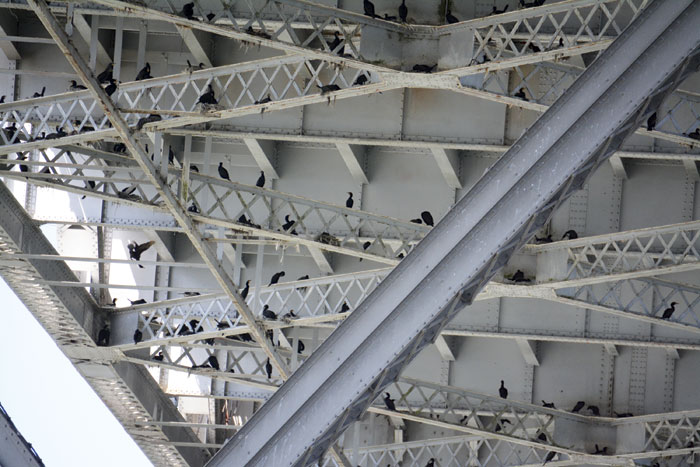
The “Old Gray Lady” is on her last legs, so the cormorants have a limited tenure. They were already evicted from the core of the colony as that section of the bridge was dismantled in 2016. A portion of the colony (187 nests were counted) moved farther east on the old bridge to an area they had never nested in before. And in the evenings, many birds have roosted on what is left of the superstructure—old habitats die hard. But this spring, they will have no choice but to move. We’re hopeful the cormorants will adopt the structures built for them on the new span, but it will take time.
So far Caltrans has tried to entice the birds to relocate to the new stainless steel “corm condos” on the new bridge through social attraction methods: cormorant decoys, prerecorded sounds of calling birds playing over outdoor speakers, mirrors to reflect their numbers, and old holiday wreaths to suggest previous nesting. But the cormorants haven’t been won over yet. Perhaps it is too different, more exposed, brighter at night? Plus they still have their old nesting grounds.
We figured that some of the displaced colony would move to the Richmond-San Rafael Bridge, which offered familiar habitat. But in our annual survey in 2016, we were surprised to see the underside of the Richmond Bridge closed off for large-scale maintenance and construction work. The core of the cormorant colony area was shuttered with what looked like huge yoga mats, preventing birds from landing on the girders under and alongside the bridge deck. Some of the birds had moved farther west on the bridge, higher over the water. The young fledgling birds there will have more difficulty reaching a safe landing place where the parents would continue post-fledging care.
In other regions, it seems cormorants are too successful for their own good. The recent sightings of cormorants banded in Oregon on the old Bay Bridge indicate the Bay population is part of the larger West Coast meta-population (albociliatus). Unfortunately, the northern colonies in the Columbia River delta are being culled because of their reputation for eating endangered salmon and steelhead. The U.S. Fish and Wildlife Service developed a comprehensive cormorant management plan that called for eliminating 11,000 cormorants from the world’s largest colony located there. A federal judge recently upheld the plan, and in 2015-16, over 7,000 cormorants were killed and over 6,000 nests had their eggs oiled. It is no surprise, then, that the colony collapsed in 2016 and the beleaguered Columbia River cormorants began showing up on the old Bay Bridge, color-banded and fitted with transmitters.
Losing the unique cormorant bridge colony in the central Bay is the end of an era. Our urban cormorants are at a crossroads. Where will they turn? Will they learn to live on the new bridge? Relocate to the South Bay salt ponds? Fly out to the Farallones, or wait out the Richmond Bridge work? I hope that once the old Bay Bridge is gone some genius cormorant will discover that the new bridge platforms are open, and the colony will begin to settle in.
We could potentially help the cormorants by rehabilitating the derelict portions of the Berkeley Pier as bird islands. Money from the Cosco Busan oil spill settlement would pay for it. Artificial islands created using the western portions of the pier could help mitigate for damage to seabird populations as a result of the spill. These “islands” would provide refuge for corms and other seabirds from sea level rise as habitat is destroyed, as well as protection from land-based predators—people, dogs, cats, rats, and cars.
But cormorants are doing fine, thank you. Double-crested cormorants have colonized urban habitats and benefited from human manipulation of San Francisco Bay. Where many species are failing to survive, the cormorant is thriving. They deserve respect for their adaptive qualities and commiseration for their commuting lifestyle. The next time you’re stuck on the bridge, watch for cormorants flying by; understandably, you might wish you could join them.
